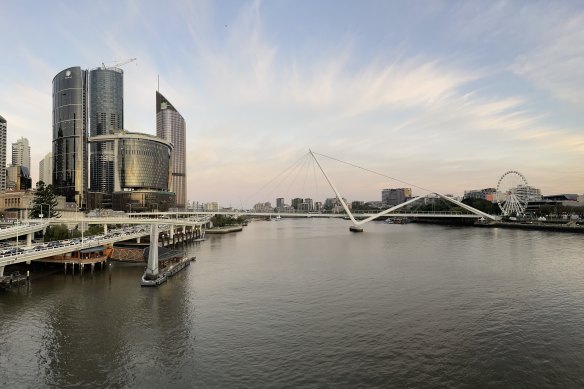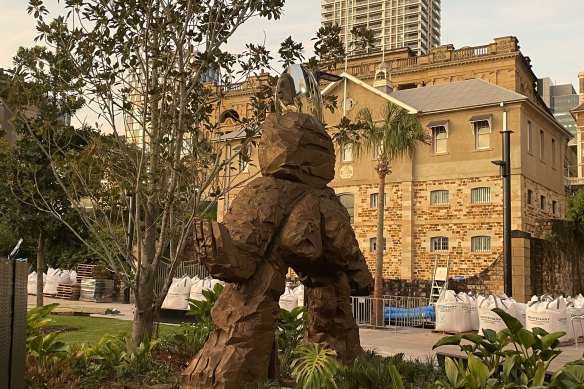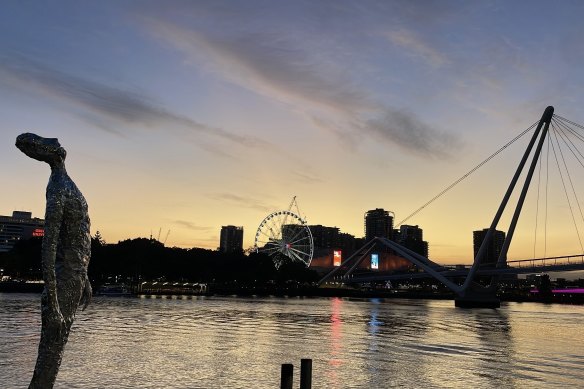- Perspective
- National
- Queensland
- Queen's Wharf
This was published 11 months ago
Queen’s Wharf a glitter strip of walkways, art and public spaces
Standing beneath artist Lindy Lee’s enormous bronze sculpture at the George Street entrance to Queen’s Wharf on Tuesday night, I had an unexpected epiphany.
Somewhere between being chided by a security guard for wandering too far into the foyer and chatting to the woman responsible for assembling Lee’s work, I caught a glimpse of the Wheel of Brisbane across the river.
It reminded me of the part of Queen’s Wharf I’m most excited to see open next week: the Neville Bonner Bridge.

I don’t care how lame it is to be excited by a new pedestrian bridge – get me strolling across that thing.Credit: Courtney Kruk
From Thursday, August 29, pedestrians will be able to wander from the wheel at South Bank, over the bridge, which was four years in the making, and into the top end of the CBD.
Fear not those who wish to avoid being drawn into the glittering clutches of the casino. You can exit the bridge at Queen’s Wharf, bypass the casino and entertainment precinct, and walk through a thoroughfare onto George Street.
If your heart so desires (and mine usually does), this positions you awfully close to Archives Fine Books by day, and whiskey bar Frog’s Hollow Saloon by night.
An added benefit to exiting the bridge under the cloak of darkness is the opportunity to see Lee’s sculpture – Being Swallowed by the Milky Way – illuminated in all its glory, a dazzling beacon for art aficionados, or a handy geographic reference for anyone who gets lost in the entertainment abyss.
Star Brisbane chief executive Daniel Finch said the group had prioritised public spaces in the first phase of openings.
Comprising 7.5 hectares of the precinct, places for free public enjoyment include the Neville Bonner Bridge, the upgraded Bicentennial Bikeway, the viewing platform on Sky Deck, Miller Park, and the Leisure Deck on Level Seven.
Sadly, no previews of the Sky Deck have made it to this masthead, but having strolled past Miller Park and along the river last week, I can confirm the patch is shaping up nicely, and Sheila, a provocative art installation from Brisbane creative Justene Williams, is proudly on display.

“Sheila” by Justene Williams is another enormous art installation for Brisbane, courtesy of Queen’s Wharf.Credit: Courtney Kruk
The “giant monument to the female form” was perplexing at first, though I must admit she has grown on me, and I think she suits the riverfront ecology and heritage buildings.
Brisbane’s cityscape is derided for many things, but rarely is criticism levelled at South Bank Parklands and the effort to transform the area into a valuable public asset as far back as the ’90s.
The riverfront stretch under Queen’s Wharf extending to QUT’s Gardens Point campus promises a similar legacy, and as an outdoor, subtropical city, it’s worth celebrating purposeful design that encourages people to explore more of it.
Which raises another point of excitement – the connection between South Bank and the Queen’s Wharf precinct is part of a bigger pedestrian vision for Brisbane.
In 2013, Brisbane City Council held an ideas fiesta to inform the CBD masterplan. It spawned a vision to transform Mary Street – virtually adjacent to Lee’s sculpture off George Street – into a major pedestrian artery.
As the plan outlined, this street will become a key connection point to the city centre, with a thread that stretches from West End to South Bank, through Queen’s Wharf and the CBD, along Eagle Street Pier and into Howard Smith Wharves.
People might scoff at the notion, but as an avid walker, I’m a fan of this ambitious strategy.
Much has been said about the Queen’s Wharf precinct. While that scrutiny has been important, there’s no turning back on this defining Brisbane development, which will start welcoming patrons in less than a week.

“Looking Up” by Tom Friedman (AKA an artist’s impression of me when I finally get to set foot on the Neville Bonner Bridge). Credit: Courtney Kruk
The nature of this role requires due diligence on all aspects of the $3.6 billion casino and entertainment precinct. But putting aside any dubious feelings about the casino itself, guaranteed good will come from the new public spaces, as South Bank proved decades ago.
That’s a silver lining I’ll happily lean into.